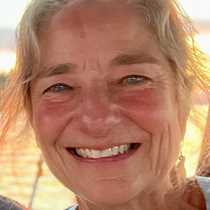Princess Louisa Inlet
Morning began so easily; gentle exercises on the sundeck, as alpenglow lit distant mountain peaks. The pink glow expanded as our bodies were stretched, welcoming a gorgeous, clear day in the fjords of British Columbia
Jervis Inlet is a long fjord encompassing Prince of Wales Reach and Queen’s Reach. As we traveled up the waterway, we saw occasional harbor seals popping their small heads up at the surface, and then slipping silently underwater. On steep mountainsides, there were clearcuts – evidence of past and current logging operations. Ben Schwantes offered an interesting talk encompassing some history of this region of British Columbia.
Sea Bird pulled in close to a rock wall, and we looked at red petroglyphs just above sea level. We could discern killer whales, fish, and a full moon. Who painted this? When? Why? We tried to imagine the experience that inspired the artwork.
At the entrance to Princess Louisa Inlet there is a bottleneck named Malibu Rapids. It is so narrow that at peak tidal current there can be standing waves as water rushes through! Sea Bird is the largest ship to navigate the narrow cut, and we must wait for slack tide to maneuver safely. We boarded Zodiacs to have the best vantage point of Sea Bird passing through. (We joked that her sides had been greased to ease her passage.) Paddlers then boarded kayaks for a 5-mile trip to the end of Princess Louisa Inlet. The colorful kayaks looked so small surrounded by fjord walls thousands of feet high. They paddled under overhanging branches of western redcedar, and past rocks decorated with chartreuse and orange lichens. They saw waterfalls, and an enormous elephant seal.
The ship anchored at the end of the inlet, near Chatterbox Falls. Ashore we strolled on an easy forest trail towards the base of the falls. The trees came alive; moss-covered branches looked like animals covered in plush, bright green fur. Huge green mounds bulged from tree trunks, and licorice ferns grew out of the soft mounds. Many branches were draped in shawls of delicate hanging moss. It was so lush, and so alive!
Morning began so easily; gentle exercises on the sundeck, as alpenglow lit distant mountain peaks. The pink glow expanded as our bodies were stretched, welcoming a gorgeous, clear day in the fjords of British Columbia
Jervis Inlet is a long fjord encompassing Prince of Wales Reach and Queen’s Reach. As we traveled up the waterway, we saw occasional harbor seals popping their small heads up at the surface, and then slipping silently underwater. On steep mountainsides, there were clearcuts – evidence of past and current logging operations. Ben Schwantes offered an interesting talk encompassing some history of this region of British Columbia.
Sea Bird pulled in close to a rock wall, and we looked at red petroglyphs just above sea level. We could discern killer whales, fish, and a full moon. Who painted this? When? Why? We tried to imagine the experience that inspired the artwork.
At the entrance to Princess Louisa Inlet there is a bottleneck named Malibu Rapids. It is so narrow that at peak tidal current there can be standing waves as water rushes through! Sea Bird is the largest ship to navigate the narrow cut, and we must wait for slack tide to maneuver safely. We boarded Zodiacs to have the best vantage point of Sea Bird passing through. (We joked that her sides had been greased to ease her passage.) Paddlers then boarded kayaks for a 5-mile trip to the end of Princess Louisa Inlet. The colorful kayaks looked so small surrounded by fjord walls thousands of feet high. They paddled under overhanging branches of western redcedar, and past rocks decorated with chartreuse and orange lichens. They saw waterfalls, and an enormous elephant seal.
The ship anchored at the end of the inlet, near Chatterbox Falls. Ashore we strolled on an easy forest trail towards the base of the falls. The trees came alive; moss-covered branches looked like animals covered in plush, bright green fur. Huge green mounds bulged from tree trunks, and licorice ferns grew out of the soft mounds. Many branches were draped in shawls of delicate hanging moss. It was so lush, and so alive!




